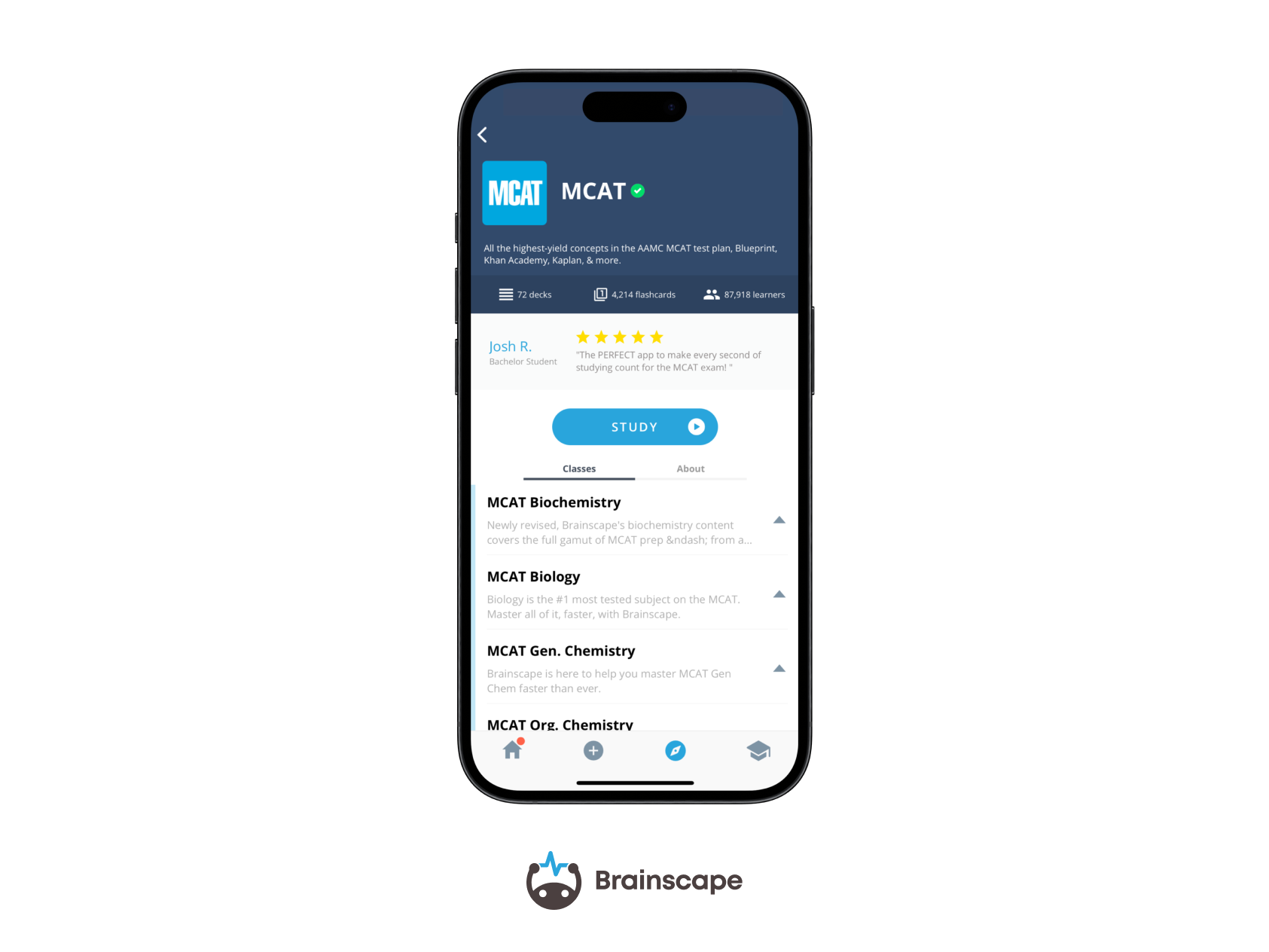A rigid study plan for the MCAT? Do you really have to be that type of anal person to do well on this important exam? The answer is yes.
At Brainscape, we're passionate about optimizing the learning process and sharing techniques that help students excel. Managing your time well with a rigorous MCAT study plan is one of them.
Consider your MCAT study plan to be your essential blueprint for success: your battle strategy for taking on and defeating the mighty MCAT. There’s a lot of content to get through and an equal (staggering) amount of practice to do. Without a plan, you risk falling behind and developing chinks in your armor.
To that end, when putting your MCAT study plan together, keep these three general principles in mind:
- Balance your time between content studying and timed practice.
- Be conservative with your goals.
- Build-in LOTS of time to review your work.
Let’s take a look at the three big questions that you need to answer for a great MCAT study schedule.
How Can You Balance Different Study Methods?
First, your study plan for the MCAT needs to be balanced. One very common mistake we see students make is over-emphasizing one aspect of prep and giving short shrift to others. Good MCAT prep is an equal mix of content review, timed simulation, and passage practice. Let's take a closer look ...
Step 1: Review Your Content
For content review, you should be using several different resources—like video, MCAT review books, digital flashcards, and concept maps—to give your brain exposure to the material in different modalities.
Your best bets here would be digital flashcards like Brainscape or Anki, which are proven to increase USMLE and MCAT scores. Via algorithms that adapt to an individual learner's progress, they improve the speed at which medical students memorize information by automating spaced repetition, which is the practice of returning to a fact at gradually increasing intervals in order to learn it faster AND press it into long-term memory.

Step 2: Learn The Content
Once you’ve put together a list of resources to learn the material, you should aim to efficiently memorize it. Research has shown vastly improved retention when students come back and review the material several times, especially after having time to sleep. It’s during that REM and deep non-REM sleep that your brain consolidates long-term memories.
So study a chapter from your book, then make and study some flashcards on that same topic. Go work on something else, get a good night’s sleep, and come back to it the next day. Quickly re-skim the chapter, re-do your flashcards, and sum it all up by watching the Khan Academy video on that topic.
Step 3: Practice MCAT Questions And Passages
You should spend as much time on practicing answering MCAT questions as you do on reviewing (and memorizing) science content. Knowing all the content down pat won’t help if you don’t practice applying it to those tricky MCAT passages. As a general rule, you should be doing at least one or two MCAT verbal passages every single day. The Critical Analysis and Reasoning Skills (CARS) section of the test is, by far, the hardest to improve on.
For science practice, you should do at least one or two practice passages on each topic you review. Do them on the second day of reviewing a chapter, after having read the chapter once, practiced the relevant flashcards, and watched the appropriate Khan Academy video. If you have trouble with the practice passage, then go back and re-review the relevant content.
Where do you get your practice passages? Typically, MCAT prep books will come with a practice passage at the end of each chapter (note that while Next Step, ExamKrackers, and Princeton Review’s books all come with such end-of-chapter passages, the Kaplan MCAT books have no practice passages in them at the time of writing).
Putting together a full suite of resources is a daunting task, but once done, you’re most of the way there. Next, you should keep the other two principles in mind.
How Can You Set Reasonable Goals For Your MCAT Study Schedule?
Be conservative with your goals! Build an MCAT study plan that only includes ~75% of what you think you’re capable of. You’re much better off planning to complete three chapters, and then finding out you’re able to get through four, rather than the reverse. Setting cautious goals helps ensure that you’ll actually achieve them and can help build up momentum and enthusiasm as you exceed them.
Conversely, setting overly ambitious goals and then failing to meet them is a fast way to develop frustration and burnout. As a general rule, I tell students who study for the MCAT full-time to plan out three 2-hour study sessions for six days a week and then take one day off each week.
Six hours may not sound like a full schedule if you’re used to working an 8- to 10-hour day full-time. But remember that the MCAT is a marathon, not a sprint. If you do three smaller chunks of studying spaced throughout the day, rather than a non-stop slog of 12 hours of studying, you’re vastly more likely to stick to your MCAT study schedule and to actually learn what you’re studying.
How Important Is Review In Your Study Plan For The MCAT?
Finally, the most common mistake I see students make in their prepping for the MCAT is failing to build in enough time to review their practice.
To really learn from your practice, you should be spacing your full-length exams out to once a week (at most!) or even once every other week. After taking a full practice MCAT, allocate anywhere from six to twelve hours to review the exam. You need to go question by question through your work, learning from every single problem—not just the handful of tricky ones that you struggled with.
Again, we cannot emphasize this enough. After completing a practice passage or a practice full-length exam, carefully review every. single. question. Allocate something like 1.5x as much time to review your practice as it took to do the practice itself.
Adding It All Up To Build A Successful MCAT Study Plan
So, to create a successful MCAT study schedule, follow these general rules:
- Review content using spaced repetition and multiple modalities
- Practice MCAT passages every day
- Do weekly online full-length exams, with an entire day to review them
- Set conservative goals that you can easily meet or exceed
And don't forget to use Brainscape's customizable MCAT study schedules and MCAT countdown planners to help you lay out the micro-steps towards your ultimate goal of crushing the exam!
Additional Reading
- How To Take An MCAT Practice Test (To Get The Most Out Of It)
- The Ultimate 3 Month MCAT Study Plan
- How to Manage MCAT Stress
References
Deng, F., Gluckstein, J. A., & Larsen, D. P. (2015). Student-directed retrieval practice is a predictor of medical licensing examination performance. Perspectives on Medical Education, 4(6), 308–313. https://doi.org/10.1007/s40037-015-0220-x
Kang, S. H. (2016). Spaced repetition promotes efficient and effective learning. Policy Insights from the Behavioral and Brain Sciences, 3(1), 12–19. https://doi.org/10.1177/2372732215624708
Kerfoot, B. P. (2010). Adaptive spaced education improves learning efficiency: A randomized controlled trial. Journal of Urology, 183(2), 678–681. https://doi.org/10.1016/j.juro.2009.10.005
Lally, P., & Gardner, B. (2013). Promoting habit formation. Health Psychology Review, 7(sup1), S137-S158.
Rasch, B., & Born, J. (2013). About Sleep’s Role in Memory. Physiological Reviews, 93(2), 681–766. https://doi.org/https://doi.org/10.1152/physrev.00032.2012
